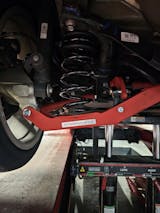Please note, these will not wire up to any LED factory equipped vehicle, including the Type R FK8.
Part Number PRO-YD-HC16AP-SEQ-BK
These projector headlights are designed to improve looks and visibility for your vehicle. They are made by OEM approved and ISO certified manufacturers. They are made with OEM standard quality and are designed for stock lights direct replacement.
This headlight DOES NOT require a CCFL inverter.
Adding HID/LED bulbs will void warranty.
What are LED's and what do they consist of?
Basically, an LED consists of several layers of semiconductor compounds. Semiconductors, such as silicon, are materials whose electrical conductivity lies between that of conductors, such as the metals silver and copper, and non-conducting materials (insulators) such as PTFE or quartz glass. The conductivity of semiconductors can be greatly influenced by the specific introduction of electrically effective external substances (by means of a process known as doping). The different semiconductor layers together form the LED chip. The type of structure of these layers (various semiconductors) has a crucial bearing on the luminous yield (efficiency) and light color of the LED.
Here are a few facts regarding LED technology:
Service life – how temperature development affects the service life
The service life or also the light degeneration of an LED refers to the period after which the illuminating power sinks to half of its original value. The functional capability of an LED depends on several factors. The semiconductor material used is as important as the operating conditions or the degeneration of the silicon crystal. The actual value of the service life cannot be generally determined, though. While standard LEDs may last up to 100,000 hours, high-power LEDs can be used for only about a quarter to a maximum of half of that time (25,000-50,000 hours). If both diodes were to be used non-stop, they could be used continually for eleven and more than two years, respectively.
The service life greatly depends on the location and the provided current density. The higher the current flow, the more the diode heats up. This shortens the service life. The ambient temperature is also relevant for the service life, as the diode fails sooner the warmer it is in general. Basically, the intensity of the light radiation in LEDs continually decreases over time. This is an advantage, as unlike traditional lamps (incandescent bulb, halogen), an LED doesn't suddenly leave you standing in the dark. Even if the illuminating power is reduced, it normally does not suddenly fail. The plastic normally used in the lenses of LEDs gradually becomes hazy, which also affects the luminous efficiency negatively.
Main factors affecting the service life
Temperature
Current density
Degeneration of the silicon crystal
LEDs are superior in several aspects. They might be more expensive to purchase than normal light bulbs or halogen bulbs, but their use pays for itself in a short time. The automotive industry in particular uses the positive features of the LED and employs it increasingly in new vehicles.
Main advantages
Low energy consumption
Long service life
Impact and vibration-resistant
Reduced heat build-up
No maintenance or cleaning costs
Mercury-free
Good glare limitation
Inertialess switching and modulation
High-quality light projection
Numerous designs (can be used almost everywhere)
Individual light source configuration
Light temperature remains during dimming
Light color can be regulated
Low production costs
Increased light output per chip
Extremely few early failures
Very compact dimensions
No UV or IR radiation
Low power consumption
High saturation
Spyder Auto Apex series shines a bright luminous steady beam with crisp cut off line up to 40% further than factory halogen bulbs.















